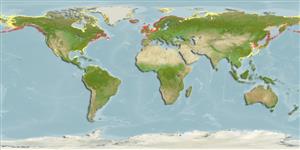Common names from other countries
Classification / Names / Names
Nomi Comuni | Sinonimi | Catalog of Fishes (gen., sp.) | ITIS | CoL | WoRMS
Environment: milieu / climate zone / depth range / distribution range
Ecologia
; distribuzione batimetrica 0 - 40 m (Ref. 83435). Subtropical
Pacific Ocean, Atlantic Ocean and the Arctic. Subtropical to polar.
Length at first maturity / Size / Peso / Age
Maturity: Lm ? range ? - ? cm Max length : 6.0 cm TL maschio/sesso non determinato; (Ref. 822)
Assumed maximum length from Ref. 822. Feeds on hydroids (Ref. 822 and 7726).
Life cycle and mating behavior
Maturità | Riproduzione | Deposizione | Uova | Fecundity | Larve
Members of the order Nudibranchia are simultaneous hermaphrodites. Mating behavior: Both individuals darts their penis toward each other to induce one to act as a male and the other as the female. The victorious one to penetrate the body wall is the dominant male. Life cycle: Eggs are deposited on a substratum where they develop and hatch into (planktonic) vestigial veliger larval stage and further grow as adults.
Behrens, D.W. and A. Hermosillo. 2005. (Ref. 822)
IUCN Red List Status (Ref. 130435)
CITES status (Ref. 108899)
Not Evaluated
Not Evaluated
Human uses
| FishSource |
Strumenti
Informazioni ulteriori
Age/Size
Accrescimento
Length-weight
Length-length
Morfologia
Larve
Abbondanza
Fonti Internet
Estimates based on models
Preferred temperature
(Ref.
115969): 1.7 - 14.2, mean 7.5 (based on 959 cells).
Vulnerability
Low vulnerability (10 of 100).
Price category
Unknown.
